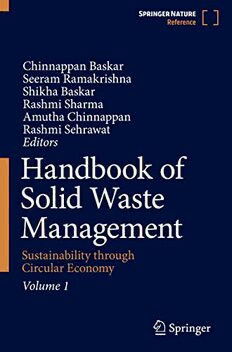
Handbook of Solid Waste Management: Sustainability through Circular Economy PDF
Preview Handbook of Solid Waste Management: Sustainability through Circular Economy
Chinnappan Baskar Seeram Ramakrishna Shikha Baskar Rashmi Sharma Amutha Chinnappan Rashmi Sehrawat Editors Handbook of Solid Waste Management Sustainability through Circular Economy Handbook of Solid Waste Management (cid:129) (cid:129) Chinnappan Baskar Seeram Ramakrishna (cid:129) (cid:129) Shikha Baskar Rashmi Sharma (cid:129) Amutha Chinnappan Rashmi Sehrawat Editors Handbook of Solid Waste Management Sustainability through Circular Economy With568Figuresand318Tables Editors ChinnappanBaskar SeeramRamakrishna ResearchandDevelopmentCenter DepartmentofMechanicalEngineering TeerthankerMahaveerUniversity CenterforNanofibersandNanotechnology Moradabad,UttarPradesh,India NationalUniversityofSingapore Singapore,Singapore ShikhaBaskar RashmiSharma ChemistryandBioprospectingDivision DepartmentofScienceandTechnology ForestResearchInstitute GovernmentofIndia Dehradun,Uttarakhand,India NewDelhi,Delhi,India AmuthaChinnappan RashmiSehrawat DepartmentofMechanicalEngineering DepartmentofBasicScience CenterforNanofibersandNanotechnology SardarVallabhbhaiPatelUniversityof NationalUniversityofSingapore AgricultureandTechnology Singapore,Singapore Meerut,UttarPradesh,India ISBN978-981-16-4229-6 ISBN978-981-16-4230-2(eBook) ISBN978-981-16-4231-9(printandelectronicbundle) https://doi.org/10.1007/978-981-16-4230-2 ©SpringerNatureSingaporePteLtd.2022 Thisworkissubjecttocopyright.AllrightsarereservedbythePublisher,whetherthewholeorpartofthe materialisconcerned,specificallytherightsoftranslation,reprinting,reuseofillustrations,recitation, broadcasting,reproductiononmicrofilmsorinanyotherphysicalway,andtransmissionorinformation storageandretrieval,electronicadaptation,computersoftware,orbysimilarordissimilarmethodology nowknownorhereafterdeveloped. Theuseofgeneraldescriptivenames,registerednames,trademarks,servicemarks,etc.inthispublication doesnotimply,evenintheabsenceofaspecificstatement,thatsuchnamesareexemptfromtherelevant protectivelawsandregulationsandthereforefreeforgeneraluse. Thepublisher,theauthorsandtheeditorsaresafetoassumethattheadviceandinformationinthisbook arebelievedtobetrueandaccurateatthedateofpublication.Neitherthepublishernortheauthorsorthe editorsgiveawarranty,expressedorimplied,withrespecttothematerialcontainedhereinorforanyerrors oromissionsthatmayhavebeenmade.Thepublisherremainsneutralwithregardtojurisdictionalclaims inpublishedmapsandinstitutionalaffiliations. ThisSpringerimprintispublishedbytheregisteredcompanySpringerNatureSingaporePteLtd. The registered company address is: 152 Beach Road, #21-01/04 Gateway East, Singapore 189721, Singapore This book is dedicated to our beloved parents Mr. S. Chinnappan & Mrs. Mariya Chinnappan; Sushila Mary; and Mr. Pawan Kumar Sambher & Mrs. Sudesh Sambher Special dedication to scientists, researchers, doctors, nurses, caretakers, hospital staff, and teachers who are combating the COVID-19 pandemic. Preface The word sustainability is derived from the French verb soutenir, which means to hold upor support.The conceptof sustainable development was framed ina 1987 UnitedNationsdocument,“WorldCommissiononEnvironmentandDevelopment: OurCommonFuture,”knownwidelyastheBrundtlandReportanddefinedsustain- abledevelopmentas“Sustainabledevelopmentisdevelopmentthatmeetstheneeds of the present without compromising the ability of future generations to meet their own needs.” It contains within it two key concepts: (i) the concept of “needs,” in particulartheessentialneedsoftheworld'spoor,towhichoverridingpriorityshould be given, and (ii) the idea of limitations imposed by the state of technology and social organization on the environment's ability to meet present and future needs. Since that time, approaches to sustainability have received increasing attention in academia,industry,andsocietywithcriticalsystemthinking,analysis,frameworks, theories, innovation, inter-/transdisciplinary research and development for the ben- efitoftheenvironment,energy,humandevelopment,andeconomicactivitiesworld- wide. The concept of sustainability goals involves many aspects that include the integration of inter/multidisciplinary knowledge, green methodologies, novel tech- nologies,andefficientuseofrenewablerawmaterialsandwastematerials. The linear economy model (take-make-use-dispose) dominated last decades of thetwentiethcenturyandthefirstdecadeofthetwenty-firstcentury,anditisavery inefficient and expensive approach, one that harms the environment or depletes natural resources. Due to the exponential growth of the global population and subsequent consumption of our natural resources, ineffective waste management, and climate change, the linear economy model can no longer be encouraged and acceptable. The circular economy model (reduce-reuse-refuse-recycle-recovery- rethink-redesign)isanewwayofcreatingvalue,andultimatelyprosperity.Circular economy is designed to be restorative and regenerative and defined as “a regener- ative system in which resource input and waste, emission, and energy leakage are minimizedbyslowing,closing,andnarrowingmaterialandenergyloops.Thiscan be achieved through long-lasting design, maintenance, repair, reuse, remanufacturing, refurbishing, and recycling.” The circular economy model has garnered increasing attention among academia, scholars, industry, governments, policy makers, and citizens as it seems to overcome the harmful consequences of vii viii Preface linear patterns of growth and is an innovative approach to achieve sustainable development. Theissueofsolidwastemanagement andfindinggreensolutionstosolidwaste managementareimportantchallengesthroughouttheworld.Basedontheconceptof sustainability,circulareconomy,greenchemistry,andengineering,thisbookaimsto provide an overview of present trends and future potential in solid waste manage- ment from different sectors into valuable green materials and products, novel methodologies, green technology, green energy, sustainability, and applications. This book consists of 89 peer-reviewed chapters contributed by renowned profes- sionals,researchers,andscientistsfromacademia,laboratories,centers,andindustry fromvariouscountries.Thisbookhasbeendividedintofourparts: (i) Solid Waste Management, Municipal Solid Waste Management, and Food WasteManagement (ii) AgriculturalSolidWasteManagement (iii) Plastic Waste Management, Rubber Waste Management, Textile Waste Man- agement,andE-WasteManagement (iv) Hazardous Waste Management, Bio-waste Management, Waste Water Man- agement,andSolidWastetoEnergy This book also features the importance of integration of multi-disciplinary researchfieldsandprovidessolutionstoaddressingallconcernedproblemsassoci- ated with solid waste management and latest research perspectives, technology development,criticalanalysisandthinking,societalrequirements,anddevelopment of green circular economy of solid waste management to researchers, scientists, engineers, environmental managers, policy makers, and experts inthe energy divi- sionofgovernmentsaswellasprivateorganizationsandindustries. We gratefully acknowledge the hard work and patience of all the authors who havecontributedtothisbookprojectduringtheCOVID-19pandemic.Wesincerely thank the Springer Nature editorial and production team, especially Dr. Stephen Yeung (Executive Editor, Major Reference Works) and Ms. Swati Meherishi (Editorial Director) and Ms Abiramy Sarangapani (Project Manager), for their suggestions and help. Our heartfelt thanks to Mr. Salmanul Faris Nedum Palli (Project Coordinator, Springer Nature) for his continuous support, dedication, and hardwork.Wewouldliketoexpressourgratitudetotheexternalreviewerswhose contributionshelpedtoimprovethequalityofthisbook. January2022 Dr.ChinnappanBaskar Prof.SeeramRamakrishna Dr.ShikhaBaskar Dr.RashmiSharma Dr.AmuthaChinnappan Dr.RashmiSehrawat Contents Volume 1 PartI SolidWasteManagement,MunicipalSolidWaste Management,andFoodWasteManagement ................... 1 1 SolidWasteManagementinDevelopingCountries:Towards aCircularEconomy .................................... 3 ZobaidulKabirandMahfuzKabir 2 ResearchTrendsoftheManagementofSolidWasteinthe ContextofCircularEconomy ............................. 37 AnaBatlles-de-la-Fuente,LuisJesúsBelmonte-Ureña, JoséAntonioPlaza-Úbeda,andEmilioAbad-Segura 3 PretreatmentsofSolidWastesforAnaerobicDigestionandIts ImportancefortheCircularEconomy ...................... 69 SabrinaVieira,JaíneSchneider,WalterJoséMartinezBurgos, AntônioMagalhães,AdrianeBianchiPedroniMedeiros, JulioCesardeCarvalho,LucianaPortodeSouzaVandenberghe, CarlosRicardoSoccol,andEduardoBittencourtSydney 4 UnderstandingCircularEconomyinSolidWasteManagement ... 95 MonikaPatel,SwetaKumari,NeetuKumari,andArkenduGhosh 5 GreenwaysforSolidWasteManagement .................... 129 AmritaKumari,AnitaRoyAich,SwetaKumari,and SamanyitaMohanty 6 WasteManagementintheChangingClimate ................ 169 ChanathipPharinoandNuchchaPhonphoton 7 FuturePerspectiveofSolidWasteManagementStrategy inIndia .............................................. 191 SamanyitaMohanty,SushantaSaha,GourHariSantra,and AmritaKumari ix x Contents 8 AssessmentofQualityofCompostDerivedfromMunicipal SolidWaste ........................................... 227 M.ChandraSekharandG.Venkatesam 9 CurrentWasteManagementStatusandTrendsinRussian Federation:CaseStudyonIndustrialSymbiosis .............. 247 AmaniMaalouf,VladimirA.Maryev,TatianaS.Smirnova,and AntonisMavropoulos 10 ATransitionTowardaCircularEconomy:Insightsfrom BrazilianNationalPolicyonSolidWaste .................... 273 LuísPaes,BarbaraBezerra,RafaelDeus,DanielJugend,and RosaneBattistelle 11 AnalysisoftheImplantationofaSystemfortheSustainable ManagementofSolidUrbanWasteinBrazil ................. 303 AntonioMarco-FerreiraandReginaldoFidelis 12 ThermalUtilizationofMunicipalSolidWasteintheCentral RegionofMexico ....................................... 317 FranciscoGutierrez-Galicia,AnaLiliaCoria-Páez, RicardoTejeida-Padilla,andVíctorRamónOliva-Aguilar 13 Developing“ZeroWasteModel”forSolidWasteManagement toShifttheParadigmTowardSustainability ................ 345 SudiptiArora,JasmineSethi,JayanaRajvanshi,DevanshiSutaria,and SonikaSaxena 14 FoodWasteManagementPracticeinMalaysiaandItsPotential ContributiontotheCircularEconomy ...................... 365 LeongSiewYoong,MohammedJ.K.Bashir,andLimJunWei 15 LifeCycleAssessmenttoSupportWasteManagement StrategiesinaCircularEconomyContext ................... 393 LinekerMaxGoulartCoelhoandRafaelladeSouzaHenriques 16 CircularEconomyApproachtoAddresstheIndustrial SolidWasteManagement ................................ 421 SalmanRazaNaqvi,BilalBeig,andMuhammadNaqvi 17 FromWastetoWealth:SteppingTowardSustainability ThroughCircularEconomy .............................. 441 RashmiPaliwal Contents xi PartII AgriculturalSolidWasteManagement ................ 465 18 RecoveryofAgriculturalWasteBiomass:ASustainability StrategyforMovingTowardsaCircularBioeconomy .......... 467 MónicaDuque-Acevedo,LuisJesúsBelmonte-Ureña, FranciscoJ.Cortés-García,andFranciscoCamacho-Ferre 19 SustainableManagementofAgriculturalWasteinIndia ....... 497 RachanaJainandSatyaNarayanNaik 20 SolidWasteManagementandPoliciesTowardSustainable Agriculture ........................................... 523 VijayKantSingh,PraveenSolanki,ArkenduGhosh,andApurbaPal 21 AgriculturalSolidWasteManagement:AnApproachto ProtecttheEnvironmentandIncreaseAgricultural Productivity ........................................... 545 FarazAhmadKhan,AnitaTomar,YogeshKumarAgarwal,and HariOmShukla 22 AgriculturalBio-wastes:APotentSustainableAdsorbent forContaminantRemoval ............................... 571 AdyasaBarik,GeetanjaliRajhans,SudipKumarSen,and SangeetaRaut 23 UseofAgriculturalWastesinCementitiousComposites ........ 593 AdeyemiAdesina 24 MassProductionofTrichodermafromAgriculturalWaste andItsApplicationforPlantDiseaseManagement ............ 619 BireswarSinha,PoorvasandhyaRajendran,and PhanjoubamSobitaDevi 25 ImpactofAgriculturalWasteCharacterizationinBiomass: SolarPVHybridMini-gridPerformance .................... 635 J.E.Bambokela,EdisonMuzenda,andMohamedBelaid 26 SimultaneousFermentativeProductionofLipaseand Bio-polymericflocculantsfromProduce(Vegetable)Wastes ..... 661 MoushumiGhosh,SurbhiSharma,andVivekSharma 27 PaddyStraw-BasedCircularEconomyforSustainableWaste Management .......................................... 683 KalyanasundaramGeethaThanuja,SubramanianMarimuthu, DesikanRamesh,andSubburamuKarthikeyan 28 CircularEconomyModelforFlorists:NeedoftheHour ........ 711 M.PonnienSelviandR.Atheeswari
